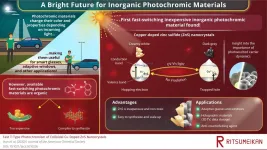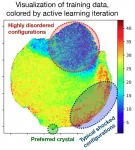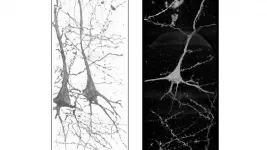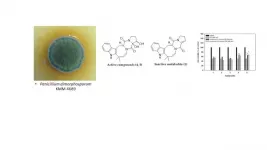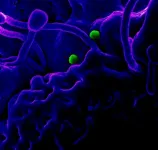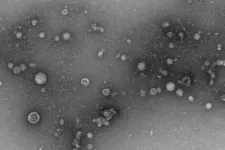(Press-News.org) Isn't it convenient when office building windows adaptively darken according to the intensity of sunlight? Or when standard glasses turn into sunglasses under the sun and switch back as you enter a building? Such feats are possible thanks to photochromic materials, whose optical (and other) properties change radically when irradiated by visible or ultraviolet light.
Today, virtually all fast-switching photochromic materials are made using organic compounds. Unfortunately, this makes them considerably expensive and complex to synthesize, requiring multi-step processes that are difficult to scale up for mass production. So, despite the myriad of potential applications these materials could enable, their commercial application has been limited. Finding fast-switching inorganic photochromic materials, which could make those potential applications widely commercially possible, has proven challenging. However, a new study published in the Journal of the American Chemical Society brings new hope in this field.
In this study, a team of scientists from Ritsumeikan University, Japan, led by Associate Professor Yoichi Kobayashi, discovered that zinc sulfide (ZnS) nanocrystals doped with copper (Cu) ions have peculiar photochromic properties. When irradiated by ultraviolet and visible (UV-Vis) light, these crystals turn from creamy white to dark grey. What's especially interesting is that when the radiation source is turned off, it takes around a full minute for the material to revert to its original creamy white color in air, but it does so in the scale of microseconds when submerged in aqueous solutions. The team proceeded to theoretically and experimentally analyze this material, determined to clarify the intricacies of its never-seen-before photochromatic behavior.
But why do Cu-doped ZnS nanocrystals change color when irradiated by light, and why can it take long for them to return to their original color? The answer, as the scientists proved, has much to do with the dynamics of photoexcited charge carriers. When a photon hits a material, the collision can energize electrons and cause them to leave their otherwise stable positions in their molecular orbitals. The absence of the electron leaves a localized positive charge that, in solid-state physics, is referred to as a 'hole.'
In most materials, the electron-hole pair exists for a very short time before cancelling each other out, re-emitting a fraction of the energy that the electron originally obtained. However, in Cu-doped ZnS, the picture is very different. Holes are effectively trapped by Cu ions while photoexcited electrons can freely hop to other molecules, and these effects delay the recombination process. As the team demonstrated, the long-lived holes alter the optical properties of the material, causing the observed photochromatic effect.
The discovery of the first inorganic nanocrystal to exhibit fast-switching photochromism represents much needed progress in this field, especially for practical applications. "Zinc sulfide is relatively non-toxic and can be easily synthesized at low cost," comments Kobayashi. "We believe our research will lead to the widespread use of fast-response photochromic materials in society." Examples of notable applications for such photochromic materials include 3D television, smart glasses, windows for vehicles and houses, and even high-speed holographic storage. They could also be used as advanced anti-counterfeiting agents for important brands and medicines.
In addition, this study has implications for researchers who are willing to dig deeper into other areas of applied optical physics. In this regard, Kobayashi remarks: "We have demonstrated that the photochromic reaction of nanomaterials can be tuned by controlling the lifetime of photoexcited carriers. Exploring novel nanomaterials with ultralong-lived excited carriers is important not only for photochromic materials, but also for various advanced photofunctional materials, such as luminescent materials and photocatalysts."
Let us hope this study paves the way for photochromism to reach our daily lives and help make our futures (adaptively) brighter!
INFORMATION:
Reference
Title of original paper: Fast T-Type Photochromism of Colloidal Cu-Doped ZnS Nanocrystals
Journal: Journal of the American Chemical Society
DOI: 10.1021/jacs.0c10236
About Ritsumeikan University, Japan
Established in 1869 with a spirit of liberalism and internationalism, Ritsumeikan University is one of the top-ranking universities in Japan; it was the first to be rated by Quacquarelli Symonds. The university now counts with three main campuses in Kyoto, Shiga and Osaka and boasts over 36,000 students. It is the No. 1 recommended destination for exchange students and even offers the opportunity to earn some degrees entirely in English. Its educational philosophy is based around peace and democracy, and the university strives to face the current era of rapid changes with a rich diversity of people and ideas.
Website: http://en.ritsumei.ac.jp/
About Associate Professor Yoichi Kobayashi from Ritsumeikan University, Japan
Yoichi Kobayashi graduated from Kwansei Gakuin University, Japan, in 2007, where he also obtained a PhD degree in 2011. He worked for the Japan Society for the Promotion of Science at the University of Toronto, Canada, and Aoyama Gakuin University for several years before joining Ritsumeikan University as an Associate Professor in 2017. He now leads a research group in the Photofunctional Physical Chemistry Lab, where they conduct cutting-edge studies on photochromism, optical nanostructures and nanoparticles, photophysics, and photochemistry. He has published over 50 peer-reviewed papers.
Funding information
This work was supported partly by JSPS KAKENHI (Grant Numbers JP18K14194, JP18H05263, 19H00888, 20K21174, 20K05419, 18H05407), Nippon Sheet Glass Foundation for Materials Science and Engineering, Grant-in-Aid for Transformative Research Areas, "Dynamic Exciton" (JP20H05832), and Masuya Research Foundation. XPS measurements were conducted at JAIST, supported by the Nanotechnology Platform Program (Molecule and Material Synthesis) of the Ministry of Education, Culture, Sports, Science and Technology (MEXT), Japan.
Thuwal/Helsinki/Leipzig. Alkanes, an important component of fuels for combustion engines and an important class of urban trace gases, react via another reaction pathways than previously thought. These hydrocarbons, formerly called paraffins, thus produce large amounts of highly oxygenated compounds that can contribute to organic aerosol and thus to air pollution in cities. An international research team has now been able to prove this through laboratory experiments with state-of-the-art measurement technology at the University of Helsinki and the Leibniz Institute for Tropospheric ...
LOS ALAMOS, N.M., February 23, 2021--A revolutionary machine-learning (ML) approach to simulate the motions of atoms in materials such as aluminum is described in this week's Nature Communications journal. This automated approach to "interatomic potential development" could transform the field of computational materials discovery.
"This approach promises to be an important building block for the study of materials damage and aging from first principles," said project lead Justin Smith of Los Alamos National Laboratory. "Simulating the dynamics of interacting atoms is a cornerstone of understanding and developing new materials. Machine learning methods are providing computational scientists new tools to accurately and efficiently conduct these atomistic ...
Neuroblastoma is a cancer that develops in nerve tissue, most commonly in the glands around the kidneys. The gene MYCN is overexpressed in 20-25% of neuroblastoma, and MYCN-amplified neuroblastoma contributes to a considerable percentage of pediatric cancer-related deaths.
Anthony Faber, Ph.D., and a team of researchers at VCU Massey Cancer Center were awarded a grant from the American Cancer Society to study how MYCN and an abundance of iron can drive cancer cell death in neuroblastoma and potentially be targeted with novel treatments. This award is the first part of a potential two-stage grant worth a combined total of $600,000.
"Iron is a double-edged sword in a cancer cell. It can help the cancer grow and survive, but it also creates ...
Schizophrenia, a chronic, neurological brain disorder, affects millions of people around the world. It causes a fracture between a person's thoughts, feelings and behavior. Symptoms include delusions, hallucinations, difficulty processing thoughts and an overall lack of motivation. Schizophrenia patients have a higher suicide rate and more health problems than the general population, and a lower life expectancy.
There is no cure for schizophrenia, but the key to treating it more effectively is to better understand how it arises. And that, according to Ryuta Mizutani, professor of applied biochemistry at Tokai University in Japan, means studying the structure of brain tissue. Specifically, it means comparing the brain tissues of schizophrenia patients with those ...
Even as more people are logging onto popular video chat platforms to connect with colleagues, family and friends during the COVID-19 pandemic, Stanford researchers have a warning for you: Those video calls are likely tiring you out.
Prompted by the recent boom in videoconferencing, communication Professor Jeremy Bailenson, founding director of the Stanford Virtual Human Interaction Lab (VHIL), examined the psychological consequences of spending hours per day on these platforms. Just as "Googling" is something akin to any web search, the term "Zooming" has become ubiquitous and a generic verb to replace videoconferencing. Virtual meetings have skyrocketed, with hundreds of millions happening daily, as social distancing protocols have kept people apart physically.
In ...
Biologically active compounds from the marine fungus Penicillium dimorphosporum protect cells from paraquat, the highly toxic herbicide with no remedy, and might enhance the action of some drugs. The fungus was isolated from soft coral collected in the South China Sea during an expedition on the Akademik Oparin research vessel. Scientists of Far Eastern Federal University (FEFU) and G. B. Elyakov Pacific Institute of Bioorganic Chemistry reported the results in Marine Drugs.
Paraquat a herbicide compound highly toxic for animals and humans. About a hundred countries, including the United States, apply it for crop cultivation and weed control. Dozens of countries, including Russia, have banned the ...
A new research study out of the University of Nevada, Reno's School of Community Health Sciences has just been published by the American Journal of Public Health and addresses state preemption of local sugar-sweetened beverage (SSB) taxes, issuing an emerging public health threat. Assistant Professor Eric Crosbie examines commercial determinants of health and public health policy, specifically in industries like tobacco and food and beverage.
"The beverage industry is aggressively attempting to preempt sugar-sweetened beverage taxes at the state level to prevent the diffusion of progressive policies at the local level throughout the United States," Crosbie, an affiliate of the University's Ozmen Institute for Global Studies, said. "Once preemption laws are enacted, ...
There is growing evidence that ketone bodies may be beneficial to heart disease patients regardless of the method of delivery used to increase ketone delivery to the heart. A Journal of the American College of Cardiology review paper examines emerging evidence regarding ketone bodies' effects on the heart and the potential for ketone therapy as a cardiovascular intervention in heart disease patients.
In recent years ketone bodies entered the popular lexicon through the "keto diet," which consists of a very low carbohydrate and high fat diet that endeavors to force the body into ketosis. This is a metabolic ...
WHAT:
A randomized, placebo-controlled Phase 1 clinical trial of two monoclonal antibodies (mAbs) directed against the coronavirus that causes Middle East respiratory syndrome (MERS) found that they were well tolerated and generally safe when administered simultaneously to healthy adults. The experimental mAbs, REGN3048 and REGN3051, target the MERS coronavirus (MERS CoV) spike protein used by the virus to attach to and infect target cells. The mAbs were discovered and developed by scientists at the biopharmaceutical company Regeneron, located in Tarrytown, New York. The trial was sponsored by the National Institute of Allergy and Infectious Diseases (NIAID), part of the National Institutes of Health.
The trial was the first to test the experimental antibodies
Hyperlink Code ...
Inflammatory lung diseases such as asthma, COPD and, most recently, COVID-19, have proven difficult to treat. Current therapies reduce symptoms and do little to stop such diseases from continuing to damage the lungs. Much research into treating chronic inflammatory diseases has focused on blocking chemicals called cytokines, which trigger cascades of molecular events that fuel damaging inflammation.
Now, scientists at Washington University School of Medicine in St. Louis have found that such cytokines can drive inflammation in more ways than previously understood, perhaps revealing new routes ...
